PART II
THE PYRAMID OF SUCCESS
On the first day of practice, Coach Wooden told us,
“Don’t worry about whether you’re doing better than
the next guy. Just give me your best. That’s all I ask.”
I knew I could do that. He had given me
a new definition of success.
—RAFER JOHNSON,
OLYMPIC GOLD MEDAL WINNER, DECATHLON;
UCLA VARSITY, 1958–59
I don’t care how tall you are.
I care how tall you play.
When my Pyramid of Success was featured on the cover of the New York Times Magazine following UCLA’s ninth March Madness national championship, most readers were puzzled. Many asked, “What is this new thing? Where did it come from?” Well, it wasn’t new, and it came from me.
As a first-year teacher in 1932 at Kentucky’s Dayton High School, I immediately became greatly disturbed by the extreme pressure many parents placed on students in my English classes. Anything less than an “A” was often viewed as failure even if the student had worked hard and done their best.
Similarly, I was greatly irritated to hear a father complain about his son’s secondary role on our basketball team when I knew it was often the best the young student-athlete could do. The father’s reaction was unfair and unproductive. It’s hard to describe my deep disappointment, even disgust, when I saw this happen time and time again.
I do not accept |
How would you feel if you’d worked hard, paid attention, done your best!—only to be called a loser by someone you respected? Regardless of age, many would simply quit trying. I did not want anyone under my supervision to ever quit trying to do their best. And few ever did.
A leader must |
Personal experience had taught me that sometimes you’re defeated even when you do your best. On those occasions when the UCLA Bruins prepared hard and played to their potential, I judged them as a success even when we were outscored, and told them so. Was there something more I could require of them beyond their best? No.
Searching for a Standard Higher than Merely Winning
Perhaps I was just trying to find a way to teach others
what my father had taught me.
Thus, during the first months of teaching and coaching at Dayton High School, I decided to develop a self-grading system that was both fair and very productive—something beyond A’s in the classroom or points scored in a game.
I remembered what Dad had told me, “Don’t worry about being better than somebody else, but never cease trying to be the best you can be.” I began thinking that success should be graded along the lines he described, by one’s effort, by how hard you try to achieve your best, whether in the classroom, sports, or life.
About this same time I read a very insightful little poem that gave me additional and specific direction:
AT GOD’S FOOTSTOOL TO CONFESS,
A POOR SOUL KNELT AND BOWED HIS HEAD.
“I FAILED,” HE CRIED. THE MASTER SAID,
“THOU DIDST THY BEST, THAT IS SUCCESS.”
That poem summed it up for me: do your best, that is success. Thus, in 1934, after very careful consideration, I wrote down my new definition of success. It is the standard I asked those under my supervision to strive for most of all. To me it is the highest and hardest standard to achieve: Success is peace of mind that is a direct result of self-satisfaction in knowing you made the effort to become the best that you are capable of becoming.
In my opinion, this definition of success creates a profoundly more productive standard than merely aiming to “outscore” somebody or trying to be better than another. Most important of all, it puts success totally under your own control. No one can give it to you; no one can take it away. No one except you. And so I began teaching this new definition of success to English students, student-athletes, and anyone else who cared to listen.
However, something unintended occurred almost immediately. What began as a search for a self-grading system for those under my supervision became the standard for success I applied to myself—the specific manner in which I began grading myself in life and leadership.
A Guide to Success: My Blueprint
Don’t judge yourself by what you’ve
accomplished, but rather by what you could
have accomplished given your ability.
Soon thereafter I recognized that only half of the problem had been addressed, namely, redefining success. As a teacher, I understood it was necessary to help those under my supervision know how to attain it; what each needed to do to achieve success as I had defined it.
That’s when I began “constructing” the Pyramid of Success—identifying those personal qualities and values that I believe are intrinsic to making the total effort to reach your potential as a person, whether in leadership or as part of a team; what it takes to do your best.
I was about to create a blueprint of my own values in life and leadership. You might call them the characteristics and qualities of success.

Coach Wooden, Indiana Teachers College, 1947
The Pyramid contains 15 personal qualities that
I believe are necessary to achieve success.
Beginning in 1934, Mr. Wooden began evaluating and identifying personal characteristics that were prerequisites for achieving success as he defined it. What must you do to acquire the peace of mind that is a direct result of self-satisfaction from knowing you made the effort to become the best you are capable of becoming?
As a teaching tool, he chose a structure that represented durability, strength, and permanence: the pyramid. During the ensuing 14 years he carefully evaluated, selected, and placed in specific locations of his pyramid the 15 personal qualities—each represented as a specific block—he concluded were necessary for achieving success, both as a leader and as a member of a fully functioning organization. He completed the Pyramid of Success in 1948, shortly before leaving Indiana State Teachers College to become head basketball coach at UCLA. It was the first thing Coach Wooden tacked up on the wall of his office at 301 Kerckhoff Hall (see page 35).
Success is peace of mind, which is a direct result of
self-satisfaction in knowing you made the effort to
become the best you are capable of becoming.

THE FOUNDATION OF THE PYRAMID
Industriousness
—HENRY WADSWORTH LONGFELLOW
There is no trick, no easy way. Success travels in the company of very hard work. Work—hard physical labor—was a constant in John Wooden’s childhood. There was no electricity or indoor plumbing. A healthy mule was considered a modern convenience.
He and his brothers quickly learned they’d go hungry if they didn’t work. It was one of the first lessons in life he learned.
It was also the first block chosen—a cornerstone—for the Pyramid of Success. He called it “Industriousness” because of his accurate assessment that the word “work” had lost real meaning. For most people, it meant going through the motions, putting in time, enduring boredom. Mr. Wooden had something else in mind.
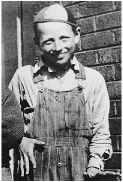
Industriousness, as he understood it, meant true work at your highest capacity; fully engaged, totally focused, and completely absorbed; no clock-watching, no punching in and out, no going through the motions.
Industriousness |
It is also something you cannot simply will yourself to do. The young teacher knew from personal experience that to reach Industriousness, a companion was necessary.
COACH WOODEN’S X’S AND O’S: |
INDUSTRIOUSNESS |
• You can work without Industriousness, but there is no Industriousness without work. |
• Only you truly know if you’re rising to a level beyond plain “hard work.” |
• “The heights …” attained by Tiger Woods, Cal Ripken, and Jack Nicklaus came from a will to win, coupled with their great will to work. |
• It is not what you achieve that matters, but what you could have achieved. Industriousness is a key—irreplaceable—factor in becoming the best you can be. |
Enthusiasm
WORK WITHOUT ENTHUSIASM IS JUST WORK.
“JUST WORK” IS NOT ENOUGH.
Your energy and enjoyment, drive, and dedication will stimulate and greatly inspire others.
As a leader, you must be filled with energy and eagerness, joy and love for what you do. If you lack enthusiasm for your job, you cannot perform to the best of your ability. Industriousness is unattainable without Enthusiasm.
At the family farm in Indiana, Johnny Wooden understood that plowing an acre of hard-baked dirt behind two mules in 100-degree July heat was hard work. He also knew that basketball practice as conducted by his high school coach, Glenn Curtis, was even harder. In fact, it was physically and mentally more grueling than field work. And yet John Wooden thrived on it. Why? Enthusiasm. His heart was in it.
Industriousness is unattainable without Enthusiasm. You must love what you do. If not, it is impossible to bring out your best.
Enthusiasm was quickly chosen as the second cornerstone in Mr. Wooden’s pyramid. Hard work is transformed into Industriousness when joined with Enthusiasm. Together they catapult your performance engine to its highest level. It is the most formidable engine of productivity.
Enthusiasm infuses and stimulates those you lead. The energy and enjoyment, drive and dedication you exude is emulated by those in your organization. According to Coach Wooden, “In my opinion, these two qualities, Industriousness and Enthusiasm, are always present in those who scale the heights—who achieve success as I define it.”
Hard work is transformed into Industriousness
when joined with Enthusiasm.
COACH WOODEN’S X’S AND O’S: |
ENTHUSIASM |
• If your heart is not in your job, you cannot work to your full potential. |
• A leader lacking Enthusiasm will infect the group with the same malady. |
• Enthusiasm is the ignition switch. Turn it on and things start happening. |
• If you lack Enthusiasm for your job, get out or at least recognize that you will never perform at your highest level. |
“WORKING TOGETHER” BLOCKS WITHIN THE FOUNDATION
Between these potent foundation cornerstones of the Pyramid—Industriousness and Enthusiasm—Coach Wooden placed three “working together” blocks, personal qualities that are necessary because most of what we do involves interacting and working with others: Friendship, Loyalty, and Cooperation.
Friendship
THE TIME TO MAKE FRIENDS IS
BEFORE YOU NEED THEM.
Strive to build a team filled with camaraderie and respect: comrades-in-arms. Friendship in the context of leadership may strike you as a perplexing choice. Is it wise for leaders to become “friends” with those under their supervision? Could it undermine decision making when hard decisions are called for?
To make a |
Coach Wooden suggests that we have friendships of different kinds: an acquaintance with whom we share an interest in politics or sports; another whose humor we enjoy; golfing, bowling, or fishing buddies. All are friends in different ways, but not in the way John Wooden means Friendship as it pertains to leadership and team building.
The two characteristics of Friendship he identifies as of supreme importance for a leader to possess and instill in team members are the following: respect and camaraderie.
Camaraderie is a spirit of great goodwill that can exist between a leader and members of the team—comrades-in-arms. Think of how much you’ll give when asked to do so by someone you respect; someone who is your comrade-in-arms. You’ll give everything you’ve got. Those under your leadership will do the same if these qualities are offered by you.
Seek to create a team that possesses camaraderie
and respect, whose members are “comrades-in-arms.”
Where it exists, you’ll find a tightly knit organization.
COACH WOODEN’S X’S AND O’S: |
FRIENDSHIP |
• Respect, esteem, and camaraderie are characteristics of Friendship necessary for a high-performance team. |
• Friendship is mutual, but the leader may have to be the first to prime the pump. |
• Friendship includes others and is a powerful bonding agent. |
• To paraphrase Abe Lincoln, “You destroy your adversary when you make him your friend.” |
Loyalty
THERE IS A DESTINY THAT MAKES US BROTHERS,
NONE GOES HIS WAY ALONE.
ALL THAT WE SEND OUT TO OTHERS,
COMES BACK INTO OUR OWN.
Be true to yourself. Be true to those you lead. Loyalty creates trust. Loyalty is part of man’s higher nature. It is also part of the nature of great teams and those who lead them. The power of Loyalty is the reason Mr. Wooden placed it in the center of the Pyramid’s foundation.
Is it possible to be a good leader without Loyalty to those on your team? Is it possible to be a good citizen without Loyalty to your country? The answer to both questions is the same. Of course not.
You must have the courage to be loyal to those you lead. This is not always easy. It starts, however, with Loyalty to yourself—your standards, your system, your values.
Give loyalty |
“To thine own self be true,” Polonius advised his son, Laertes, in Hamlet. Coach Wooden extends that exhortation: “First, do not betray yourself. Second, do not betray those you lead.” This is Loyalty.
People do not arrive at your organization’s doorstep with Loyalty. It comes when they perceive that your concern for their interests and welfare goes beyond simply calculating what they can do for you or how you can use them to your advantage.
John Wooden believes that most people—the overwhelming majority—wish to be in an organization whose leadership cares about them; provides fairness and respect, dignity and consideration; and holds them to high standards.
Do this and you will find Loyalty in abundance from those you lead. You will find yourself in charge of an organization that will not waffle in the wind.
For that to happen, you must be true to yourself and your team. You must have Loyalty to those you lead. And when you give it, you will get it back from your team.
COACH WOODEN’S X’S AND O’S: |
LOYALTY |
• First, be true to yourself and your beliefs. Second, be true to your team. |
• Respect is a prerequisite for Loyalty. You gain respect by giving respect. |
• Just as you cannot be a good citizen without Loyalty to your country, neither can you be a good leader without Loyalty to your team. |
• Let those you lead know you have sincere care, concern, and consideration for their welfare and you will generate great Loyalty from those on the team. |
Cooperation
MAKE SURE THE PEOPLE YOU LEAD
FEEL THEY’RE WORKING WITH YOU, NOT FOR YOU.
Have the utmost concern for what’s right rather than who’s right. For this to occur, the final block of the pyramid’s foundation must be present and active: Cooperation.
It is often difficult for a strong-willed leader to incorporate Cooperation because listening to others, evaluating, and embracing their opinions and creativity may seem to suggest uncertainty and doubt about your own judgment and convictions. The ego gets in the way of your eyes and ears. It’s easy to get lost in your own tunnel vision.
Much can be |
An effective leader understands it is a sign of strength to welcome honest differences and new ideas from those on your team as well as others. Progress is difficult when you won’t listen. Cooperation is impossible if we refuse to consider the merits of contrary opinions.
A dictator-style leader is all answers and no questions. The most effective leader incorporates the productive ideas and creativity of others, knowing it makes things work better. That’s what John Wooden seeks: not just making something work, but making it work better and better.
Cooperation—the sharing of ideas, creativity, responsibilities, and tasks—is a priority of effective leadership. The only thing that is not shared is blame. A strong and secure leader accepts blame and gives the credit. A weak insecure leader gives blame and takes credit.
In basketball, one of the undervalued acts that Coach Wooden most values is the assist—helping a teammate score a basket. The assist in basketball epitomizes Cooperation. The assist is valuable in all organizations—helping someone do their job better. It makes “scorers” out of everyone.
COACH WOODEN’S X’S AND O’S: |
COOPERATION |
• Much can be accomplished when nobody cares about who gets the credit. |
• “One hand washes the other” is a good motto for a team seeking Cooperation. |
• A strong team of field horses pulling in different directions will go nowhere. |
• Seek the right way, not just having it your way. |
THE SECOND TIER OF THE PYRAMID
John Wooden chose four traits for the Pyramid’s second tier that primarily involve control and direction of your mental and emotional faculties. The first quality block is the most explicit in this regard.
Self-Control
IF YOU DO YOUR BEST, NEVER LOSE YOUR TEMPER,
AND NEVER BE OUT-FOUGHT OR OUT-HUSTLED,
YOU’LL HAVE NOTHING TO WORRY ABOUT.
Control of your organization begins with control of yourself. Be disciplined. Getting to the top, even once, is most difficult. Staying there is arduous. Mr. Wooden understands that both getting there and staying there present unique and formidable challenges. To do either requires great personal discipline: Self-Control.
Control of self is essential for consistency in leadership and team performance. Coach Wooden views consistency as a trademark of the true competitor and effective leader. This is impossible to achieve without Self-Control.
Discipline |
Self-Control is necessary in all areas. The choices you make in your personal life affect your professional life. They are not separate. A leader who lacks Self-Control outside the organization may lack it within the organization.
It starts with control of your emotions, but it extends to having the resolve to resist the easy choice, the expedient solution, and, at times, temptation in all its alluring forms.
Self-Control in little things becomes Self-Control in big things. Coach Wooden prohibited profanity during practices and games because it showed loss of control. In this small way—prohibiting profanity—he taught Self-Control that could be applied in other areas.
He told his teams that when they lose control, they make themselves vulnerable. The same is true for a leader who lacks Self-Control.
How did he teach Self-Control? In large part through his own example. His personal control of self became more and more effective over the course of many years. Ultimately it led an announcer to proclaim during a game, “Coach Wooden must be very upset. He just raised an eyebrow!”
COACH WOODEN’S X’S AND O’S: |
SELF-CONTROL |
• You cannot function responsibly and productively if you lack personal discipline—especially in the area of emotions. Anger is the most common culprit, but not the only one. |
• Clear thinking is clouded by emotionalism. |
• Self-Control creates consistency. Consistency is crucial to getting to the top and staying there. |
• An undisciplined team is the best evidence of an undisciplined leader. |
Alertness
NOTHING IS STATIC. EXPECT EACH DAY TO
BRING NEW THREAT AND OPPORTUNITY.
Constantly be aware and observing. Always seek to improve yourself and the team. Alertness—the ability to observe, absorb, and understand what’s going on around you—is a critical component for the individual in charge, the leader, as well as those he leads.
Never be a |
You must constantly be awake, alive, and alert in evaluating yourself as well as the strengths and weaknesses of your organization and those of the competition.
In sports today we see instantaneous adjustments during play: video, photos, and spotters in the booths with binoculars providing immediate information on the game.
Should it be different with you and your team? The same sense of urgent observation—Alertness—must exist in you and be taught to those under your supervision.
A leader who is sluggish in recognizing what’s going on will soon be going on without a job.
John Wooden’s father liked to remind him that most of what he’d learn in life would come from others. That can happen only if you exhibit Alertness. A driver who’s asleep at the wheel, not alert, will crash. The same happens to organizations whose leader does not exhibit Alertness. To learn, you must listen. Coach Wooden advises, “Don’t just act like you’re listening. Really listen. Good leaders are good listeners.” It helps heighten Alertness.
Alertness must exist in you and be taught
to those under your supervision.
COACH WOODEN’S X’S AND O’S: |
ALERTNESS |
• Perfection doesn’t exist. Thus, actively be alert and looking for imperfections in your team and your competition. It is there. Find it. |
• Stick to your guns, but be open to change or you will be blindsided. |
• Sports teams are constantly adjusting during a game to what the opponent does. Do the same. |
• “Heads-up” leadership is alert to opportunity, threat, trends, and changes. |
Initiative
FAILURE TO ACT IS OFTEN THE
BIGGEST FAILURE OF ALL.
Have the courage to make decisions and the willingness to risk failure. A basketball team that won’t risk mistakes won’t win many games. The same is true for any organization. Fouls, errors, and mistakes are part of the competitive process in sports, business, and life. Not careless or sloppy mistakes, but those resulting from assertive action based on proper assessment of risk.
John Wooden’s outstanding coach at Purdue, “Piggy” Lambert, summed it up like this: “The team that makes the most mistakes wins.” He was talking about the next block of the pyramid: Initiative.
Assume failure. |
Many leaders instinctively behave like a young college basketball player who picks up three quick fouls in the first half and becomes cautious, tentative, and timid. A smart coach will sit this player on the bench before he can hurt the team.
The tentative business leader, however, stays in the contest, to the eventual detriment of the organization. Hesitancy brought on by fear of failure is not a characteristic of great leadership. Play to win rather than “not to lose.”
Coach Wooden instructed players, “Be quick, but don’t hurry.” Once you’ve decided on a course of action, take action. Initiate quickly, but not carelessly or in a fashion so hurried that a miscue is more likely.
Do not be afraid to fail. Use good judgment and then use Initiative. The leader who fears failure will often fail to act when action is required.
As a rule, Coach Wooden never benched or admonished a player who tried in an intelligent way to make something happen on the court—even when they failed. He did not want an environment where individuals were afraid to risk failure.
A leader must have Initiative—the courage to make
decisions and the willingness to risk failure.
COACH WOODEN’S X’S AND O’S: |
INITIATIVE |
• Fear of failure is often the biggest failure of all. |
• Have the courage to believe that you have nothing to fear when you’ve prepared your organization to the best of your ability. |
• Respect all. Fear none. |
• Never rebuke someone who makes a mistake after careful planning and proper preparation. |
Intentness
IT’S NOT WHO STARTS THE GAME,
BUT WHO FINISHES IT.
Stay the course. When thwarted, try again—harder, smarter. Persevere relentlessly. Intentness is as important as any single block in John Wooden’s Pyramid of Success. Without it you will falter, fade, and fall.
Mr. Wooden chose the word Intentness to suggest persistence and determination, fortitude and resolve. All of these traits are present in a great leader.
Never be satisfied. |
When Intentness exists within you, it also will exist within your organization. Unfortunately, the reverse is also true. Leaders lacking Intentness will find themselves leading teams intent on quitting, on finding the nearest exit.
Intentness also implies a firm resolve to stay the course over the long term rather than a burst of short-lived activity.
Intentness keeps you in the game even when others tell you the game is over. The game is over only when you, the leader, say so.
Good things take time, usually lots of time. Achieving worthwhile goals requires Intentness. There are setbacks, losses, unexpected reversals, hardships, and bad luck. Does the fight continue? The team looks to you for their answer. Your answer is Intentness.
Industriousness and Enthusiasm are a powerful combination essential to Success. But the great force they produce must be constant and ongoing. They require Intentness.
Things achieved without effort are seldom
worthwhile or long-lasting.
Condition
WHAT YOU DO AWAY FROM PRACTICE CAN TEAR
DOWN ALL WE ACCOMPLISHED DURING PRACTICE.
Ability may get you to the top, but character keeps you there: mental, moral, and physical. Obviously physical conditioning is necessary—good health, vitality, and energy. However, in choosing Condition as a block in the heart of the Pyramid, Coach Wooden went beyond physical assets.
He understands that to achieve your leadership potential, you must also possess mental and moral strength. All three are present in this next block: Condition.
How does one attain moral Condition? John Wooden has prescribed a commonsense method for decades: Practice moderation and balance in all that you do.
Following a grueling basketball practice aimed, in part, at building up the players’ physical strength, he would advise them of the following: “All we’ve worked so hard to accomplish on the court today can be torn down quickly, in a matter of minutes, if you make the wrong choices between now and our next practice.”
Be concerned |
He cautioned that when moderation and balance are lacking in their choices and subsequent actions, the team can be damaged. To help them understand what he meant—that ultimate responsibility for success lay with them—Coach Wooden occasionally posted the following reminder on the UCLA team bulletin board:
“There is a choice you have to make, in everything you do. So keep in mind that in the end, the choice you make, makes you.”
And, of course, the choices made by the leader count most of all because they ultimately make, or break, your team.
Mental, moral, and physical Condition—in balance—are crucial to effective leadership. A leader who lacks physical Condition is less likely to summon the mental strength to stand up and fight for beliefs and convictions. You may have observed how those who weaken themselves physically often fall prey to an assortment of lapses in the area of good judgment.
Condition—physical, mental, and moral—is essential to being an effective and consistent leader. That’s why Condition is in the center of the pyramid, so close to the heart of the structure.
COACH WOODEN’S X’S AND O’S: |
CONDITION |
• Character constitutes a component of Condition. |
• What you do off the job is directly related to how well you do on the job. |
• Moderation and balance are significant factors in attaining proper Condition. |
• Physical Condition is impossible without mental and moral Condition. |
Skill
WHEN YOU ARE THROUGH LEARNING,
YOU ARE THROUGH.
What a leader learns after having learned it all counts most of all.
Fundamentals in basketball means having comprehensive knowledge of the X’s and O’s and physical mechanics of the game—where to go and when to go there; how to shoot a shot or block a shot correctly.
We can appreciate that Skill is a requirement not only in basketball for both a coach and the players, but for any leader and organization. You must know what you’re doing. Thus, Skill is at the very heart of the pyramid.
Know your job and be able to do it quickly and correctly. Knowledge of and the ability to execute your responsibilities will separate you from most of the competition. This means being prepared to do all that your job requires.
Push yourself |
Mr. Wooden saw many coaches who could teach offense but were limited in their knowledge of defense. As a coach, he had players who were skilled shooters, but couldn’t get open. Others were skilled at getting open, but couldn’t shoot.
Whether in basketball or in business, you must be able to “get open” and “shoot.” One without the other makes you a partial performer: one who can be replaced because your skills are incomplete; one whose leadership falls short because of your own limitations when it comes to knowing your job.
The skills necessary for leadership differ from organization to organization. Those required to manage a restaurant differ from those of a sales manager, just as coaching basketball has different requirements from coaching baseball. But regardless of the skills a particular profession requires, you must master them.
You must also be fully aware that mastery is a lifelong process of learning. The best leaders are those who realize it’s what you learn after you know it all that counts most.
COACH WOODEN’S X’S AND O’S: |
SKILL |
• Complete competence is required. You must be able to execute all elements of your job or you are a partial performer. |
• Experience is valuable. Skill is more valuable. Together they are invaluable. |
• Skill means you can execute all facets of your job properly and quickly. |
• Knowing what you’re supposed to do means little if you don’t have the Skill to do it. |
Team Spirit
THE STAR OF YOUR TEAM IS THE TEAM.
“We” supersedes “me.”
Initially, Mr. Wooden defined Team Spirit as “a willingness to lose oneself in the group for the good of the group.” Something about this definition was bothersome to him, but he couldn’t put his finger on the problem.
Then one morning at breakfast he read a magazine article about a person who was described as having “an eagerness” to do some professional activity he was involved in. Coach Wooden recognized what had been wrong in his initial definition of Team Spirit.
Unselfish team |
A “willingness” to be selfless does not satisfy his requirements. It suggests begrudgingly doing what is required for the team’s welfare. Coach Wooden wanted each player to be eager to sacrifice personal interests for the good of the group. Thus, as the pyramid was nearing its final form, he changed that one word in the definition: “willingness” became “eagerness.”
Team Spirit—an eagerness to sacrifice personal interests or glory for the welfare of the group—is a tangible living force that transforms individuals who are “doing their jobs willingly” into an organization whose members are dedicated and eager to work at their highest level for the good of the group.
When this happens, the result is transformative. Just as Enthusiasm ignites Industriousness, Team Spirit is a catalyst for raising all the supporting qualities of the Pyramid to extraordinary heights because it creates a deep desire to do everything within your potential to strengthen your team.
When Team Spirit exists within your organization, the resulting productivity is exponential: your team becomes greater than the sum of its players; the organization greater than the talent and size of its personnel.
CEOs increasingly are media personalities whose own star—they seem to believe—shines brighter than the organization they lead.
There is only one star of importance: the team. The player or leader who seeks to have his or her star shine brighter than the group’s is someone Mr. Wooden would want to neither coach nor play for.
COACH WOODEN’S X’S AND O’S: |
TEAM SPIRIT |
• Comprehend the difference between “willingness” and “eagerness,” “selfishness” and “selflessness.” Teach your team the difference. |
• Team Spirit means you are willing to sacrifice personal considerations for the welfare of the organization. |
• Team Spirit starts at the top. The leader, you, must personify Team Spirit. |
• There is only one star that matters. The team is the star that matters. |
GETTING TO THE TOP: TRADEMARKS OF GREATNESS
The Good Book says, “As ye sow, so shall ye reap.” The three tiers of the Pyramid that are now in place allow you to reap a rewarding and profound bounty, one that will produce two qualities closely identified with John Wooden and his teams. They are the two blocks near the apex of the Pyramid.
Poise
IF YOU CAN MEET WITH TRIUMPH AND
DISASTER AND TREAT THOSE TWO IMPOSTORS
JUST THE SAME . . .
—RUDYARD KIPLING
Just be yourself. Don’t be rattled by events, whether good or bad. This may sound easy, but Poise can be a most elusive quality in challenging times. Leaders lacking Poise panic under pressure.
Poise means holding true to your belief that what counts most are your own high standards and making the effort to do the best of which you are capable regardless of how bad, or good, the situation may be.
Poise means being true to yourself even if it goes against popular sentiment, even if you must stand alone. It means avoiding pose or pretense, comparing yourself to others, acting like someone you’re not. It means having a brave heart in all circumstances.
You’ll know you possess Poise when you achieve what Rudyard Kipling described above in his poem written a hundred years ago.
That’s Poise—not being thrown off stride in what you believe or how you behave because of outside events—“keeping your head when all about you are losing theirs.”
The competitive environment challenges your composure and equanimity on a continuing basis as the stakes get high. Few characteristics are more valuable to a leader than Poise—especially under pressure. And pressure is what leaders are paid to deal with.
When Poise is present, you’ll perform at your own personal best because Poise precludes panic. You’ll understand what you’re supposed to do, and do it even when the odds are against you, even when the experts say you’ll fail.
How do you acquire Poise? In fact, you don’t. Poise acquires you. It is part of the harvest you reap near the top of the Pyramid. Suddenly it is there, part of you and your leadership style and substance: Poise. It also becomes the style and substance of your organization.
Have respect for, without fear of,
every opponent, and confidence without
cockiness in regard to yourself.
Confidence
YOU MUST EARN THE RIGHT TO BE CONFIDENT,
THE KIND OF CONFIDENCE THAT COMES FROM
PROPER PREPARATION.
The strongest steel is well-founded self-belief. It is earned, not given. Self-belief is the knowledge that your preparation is complete, that you have done all things possible to ready yourself and your organization for the competition in whatever form it arrives.
Confidence cannot be grafted on artificially. Real abiding Confidence, like Poise, is earned only by tenaciously attaining those assets that allow you to reach your own level of competency. For John Wooden, those assets are contained in and offered by the aforementioned personal characteristics and qualities of the Pyramid of Success.
Confidence must be monitored so that it does not spoil—rot—and become arrogance, the feeling of superiority that fosters an assumption that past success can be repeated automatically without the same hard effort that brought it about in the first place.
Thus, Coach Wooden has never gone into a game assuming victory. Neither did he ever assume defeat. He assumed nothing other than that he had taught those under his supervision how to bring out their best in competition. “Every opponent is to be respected; no opponent is to be feared if you have prepared properly.” This is what he taught those under his supervision.
In fact, the quality, or lack thereof, of the competition had nothing to do with his level of Confidence. Rather, he drew strength from the sure knowledge that he had done all things possible to prepare himself and the team to perform at their highest level.
The competition may perform at a higher level, or not. He didn’t concern himself with the competition’s potential. His focus was on achieving his own potential as a leader and teaching his players how to do it as a team, an organization exhibiting the crowning characteristic of his pyramid.
Success requires Poise and Confidence, which come with proper preparation. It is the belief of John Wooden that acquiring the personal characteristics and values of the pyramid is, in fact, maximum preparation.
When you have prepared properly—and do not underestimate the great challenge of proper and complete preparation—you will acquire the final—ultimate—block of the Pyramid of Success.
You must earn the right to be confident.
COACH WOODEN’S X’S AND O’S: |
CONFIDENCE |
• Believe in yourself and others will believe in you. |
• Well-founded Confidence is contagious. |
• Confidence must not become arrogance. |
• All supporting tiers of the Pyramid of Success give you the right to be Confident (and have Poise). |
WHAT IT’S ALL ABOUT
Competitive Greatness
For over half a century, John Wooden has defined Competitive Greatness as follows: Performing at your best when your best is needed; a real love for the hard battle.
The great competitors he has played for, coached, and admired through many decades share a joy derived from the struggle itself—the journey—because only in that great effort of preparation and performance is there opportunity to bring forth your best, a personal greatness that cannot be diminished or dismissed because of a final score or the bottom line.
Competitive Greatness, for John Wooden, is not defined by Rudyard Kipling’s “triumph” nor denied by “disaster.” It exists in what precedes those two “impostors” and their accomplices fame, fortune, and power—conventional measurements of Competitive Greatness (and success) that Mr. Wooden reconfigured long ago. Competitive Greatness exists in the journey and culminates in the tough competitive fight in which you and your organization are at your best because you’ve prepared to the full extent of your abilities.
Subsequently, there is nothing tiresome for Mr. Wooden in the old adage, “When the going gets tough, the tough get going.” He has tried hard to meet that criterion and teach it to others throughout his career.
This is one of the most crucial concepts a leader can carry and convey to those within the organization: namely, a love for the hard battle and the test it provides against a worthy opponent. The struggle is to be welcomed, never feared.
When you define success as John Wooden does, the only thing to fear is your own unwillingness to make the effort—100 percent—to achieve your potential in leadership and teach those on your team how to achieve Competitive Greatness as an organization.
A Great Competitor welcomes the worthy opponent and the hard battle and defines success, first and foremost, by performing at their best when their very best is needed. A great leader teaches the organization to do the same. He also teaches that the “score” will then take care of itself.
When this occurs, it means you have arrived at the top, prepared to bring out the best in yourself and those under your leadership. You are a Great Competitor who leads a team capable of Competitive Greatness.
The struggle itself—the journey—is what gives value to the prize and is something the great competitive leader truly revels in. It is your responsibility to teach those under your supervision the same.
SUMMARY
• A pyramid has traditionally symbolized longevity and durability, strength and power.
• John Wooden chose the pyramid structure because it offered a format that was an effective teaching tool: each block assigned a value, each tier built on what came before. All leading to the apex—Success: peace of mind that is a direct result of self-satisfaction in knowing you made the effort to become the best you are capable of becoming.
• “Work” for most means going through the motions. Mr. Wooden had something else in mind and chose a word to reflect that: Industriousness.
• Industriousness is not possible unless it is partnered with Enthusiasm. Together they become the engine that drives everything forward with great power.
• Most everything that we do involves working with others. Mr. Wooden chose three blocks that are necessary for this to be done well: Friendship, Loyalty, and Cooperation. Together they represent the “working together” blocks in the Pyramid’s foundation.
• Self-Control, Alertness, Initiative, and Intentness extend the foundation’s characteristics and provide support for the heart of the pyramid.
• The heart of the Pyramid of Success is Condition (physical, mental, and moral), Skill, and Team Spirit.
• Near the apex, Coach Wooden placed Poise and Confidence. They come to you with proper preparation: the first three tiers.
• Competitive Greatness is possessing the ability to do your best when your best is needed. It comes with preparation and a love of the hard battle.
Personal greatness is not determined by the size of the
job, but by the size of the effort that one puts into the job.
This applies to everyone on your team.
FAITH AND PATIENCE: SYMBOLIC MORTAR
John Wooden added “mortar” at the top of the pyramid with the qualities of Patience and Faith.
They are symbolic and remind us that Patience and Faith must be present throughout the pyramid, holding the blocks and tiers firmly in place. A leader must have Faith that things will work out as they should—a boundless belief in the future.
A wise leader also knows that good things take time. If difficult goals could be achieved quickly, more people would be achievers. But most people—many leaders—lack Patience.
Success is always attainable when defined correctly; that is, making the effort—100 percent—to do the best of which you are capable. The 15 personal qualities of the pyramid are Coach Wooden’s building blocks for success. You, and no one else, control whether you achieve success. You have it within your grasp, within your own power, to make the total effort. As leader, you have the responsibility to teach your organization how to do it.
Ultimately, the words of Joshua Hugh Wooden, Coach’s father, describe it well: “When you’ve done your best, you may call yourself a success.” You may also call yourself a Great Competitor—a leader who resides at the top of the pyramid where success and you are one and the same.
Big things are accomplished only through
the perfection of minor details.
Success
As a teacher, coach, and leader, John Wooden’s goal has always been to help members of the team achieve their potential both individually and as a group.
The 15 personal qualities of the Pyramid are a simple way of illustrating what he required. In clear terms, it shows what he expected of them and what they could expect from him. As a teacher, success was his subject, the Pyramid of Success was his textbook.
Success may result in winning, but
winning does not necessarily
make you a success. Success, as I
define it, is harder to achieve.
SUMMARY
For John Wooden, success comes from the knowledge that you made the full effort to do the best of which you are capable.
When asked, “Coach Wooden, how did you win those championships?” he answers as follows: “I didn’t win a single championship. Our team did. I like to believe that my teaching helped them accomplish that. The quality of my teaching and leadership and the effort I put into it is where I found—and continue to find—my defining and ultimate success. Not in the final score.” But he will usually add, “And if the final score was to my liking, that made it all the better.”
While others will judge you strictly in relation to somebody or something else—the final score, the bottom line—this is neither the most demanding nor the most productive standard. Throughout John Wooden’s career, he did not allow others to define success for him, to impose their version of success on his leadership.
He sums it up simply:“If I did my best I believed in my heart that I was a success. Whether our team won a championship or not had little to do with my final reckoning of my success.”
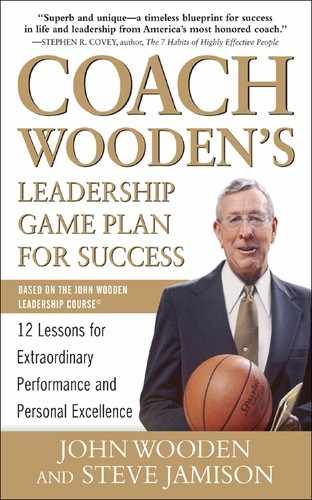
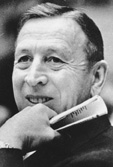
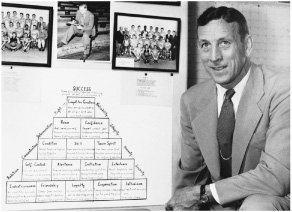
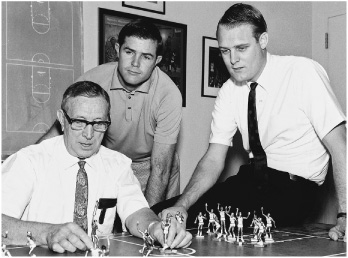
 COMPASS CHECK
COMPASS CHECK





































